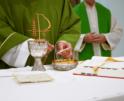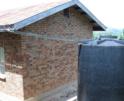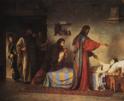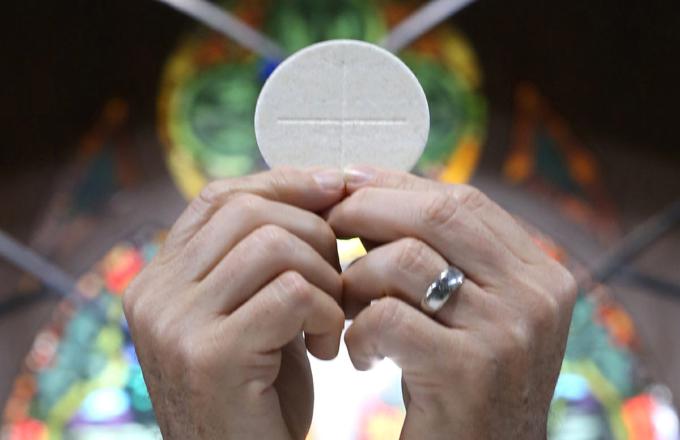
Faith
Who is the original author of this prayer? We do not have a definite answer. But as we'll see in the coming weeks, the authors of prayers are supposed to remain anonymous, and EP II, while based on Hippolytus's prayer, is also a reworking of the prayer.
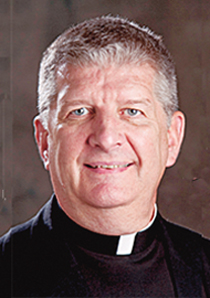
O'Grady
This is the oldest, and it seems the most widely used, of the Eucharistic Prayers in the Roman Missal. To be honest, it is probably widely used because it is the shortest, only about one-third the length of the Roman Canon. It also seems to be the easiest to follow, with few insertions and no list of saints, only the Blessed Virgin and St. Joseph.
By design or accident of history, we do not know the authors of most of the Eucharistic Prayers. In the case of this one, we have a name customarily associated with the prayer that is the model for Eucharistic Prayer II.
The name is Hippolytus. He was a third-century Roman cleric; he was certainly a priest and likely a bishop. He was the first "antipope" and the only antipope in the Roman Martyrology -- not an easy feat, setting yourself against the pope and ending up a saint and on the pope's list of saints!
Few, if any, prayers were written down. Celebrants enjoyed a great deal of freedom in ad-libbing prayers. In fact, it was the only way they could pray. Yes, they did have some guidance, and imitation being even then the highest form of flattery, celebrants copied each other's styles and words -- no copyrights to worry about.
Precisely because they were both "going on too long" and were incorporating their own "theology," Hippolytus began to provide patterns (written) for prayers for Mass. These were collected and often moved about the Roman Empire. The book in which these were collected was titled "Apostolic Tradition" -- a title given to other texts as well. Somehow or other, Hippolytus's name got attached to this collection. The pattern for the Eucharistic Prayer in the collection is connected to another prayer, that for the ordination of a bishop. And that prayer is the one that we use today for the ordination of bishops.
Who is the original author of this prayer? We do not have a definite answer. But as we'll see in the coming weeks, the authors of prayers are supposed to remain anonymous, and EP II, while based on Hippolytus's prayer, is also a reworking of the prayer.
The reworking is more in some minor details. The preface is separated by the Holy, Holy, Holy from the rest of the prayer. Some stylistic changes were made so that the format matches the now customary format for all Eucharistic Prayers in our Roman Missal.
Speaking of the preface, there is one that is "preferred" to be used with his prayer and in the Missal it is printed as the beginning of the prayer. If there is no feast or season that would suggest otherwise, the preferred preface ought to be used. However, if this prayer is widely used, as seems to be the case, the variety of the prefaces should not be lost, and so priest celebrants can and ought to make the prayer a bit more "varied" using the several options among the prefaces.
As mentioned previously, this prayer has no list of saints, restricting names to only the Blessed Virgin and St. Joseph, his name inserted by Pope Francis. Part of the reason for this was that this Eucharistic Prayer is also widely used in other Christian communities. So, there was a certain ecumenical sensitivity in the reworking. This means that when there is a saint's day being celebrated, this Eucharistic Prayer should not be chosen since it is not permitted to add a saint's name. Again, this is easily seen by the layout of the text of the prayer in the Missal.
On the other hand, there is a place to insert the name of a deceased when a Mass for the Dead is celebrated. This is especially appropriate at the funeral Mass.
As we saw last week, there are also cases where there are insertions that can be used if this prayer is chosen for occasions such as baptisms, confirmations, ordinations, marriages, anointings of the sick, or certain blessings of persons or things. Those special inserts are with the other Mass prayers for the specific occasion and so the celebrant needs to be aware of the need to mark with ribbons the places to which he will need to turn the pages.
When the prayer was being prepared for use, it was hoped that it would be more often used for weekdays. Indeed, hope seems to have been fulfilled and exceeded, and prayer is now frequently used at Sunday Masses as well.
For texts and more information on all the current Eucharistic Prayers in the Roman Missal, check out this excellent site: catholic-resources.org/ChurchDocs/EP.htm.
Recent articles in the Faith & Family section
-
Eucharistic Prayers for Reconciliation and for Masses with ChildrenFather Robert M. O'Grady
-
Mainstay of Seminarians in the Missions: The Society of St. Peter ApostleMaureen Crowley Heil
-
Arise!Scott Hahn
-
The opportunity of summer: Build and repair relationshipsDr. R. Jared Staudt
-
Why does the Catholic Church oppose contraception?Jenna Marie Cooper

